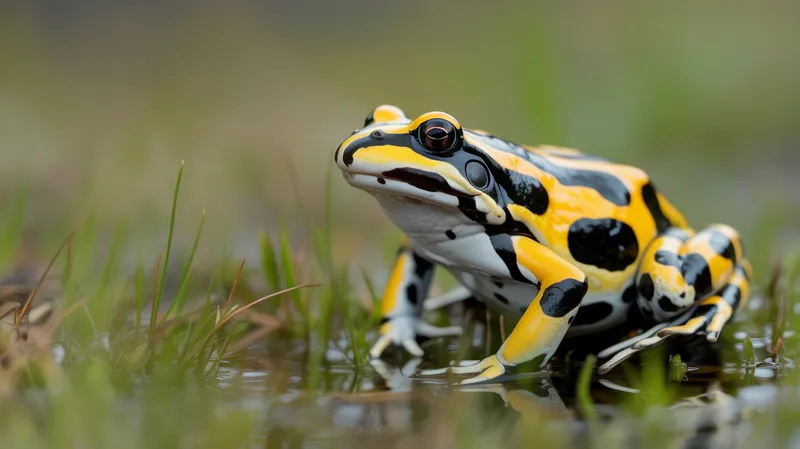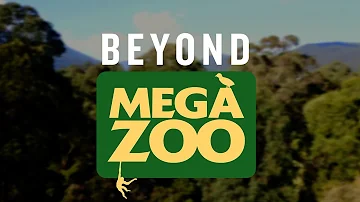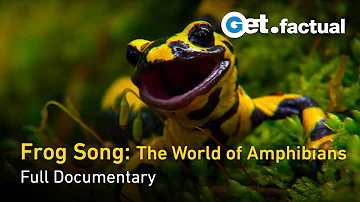
Corroboree Frog
Pseudophryne corroboree

Meet the Corroboree Frog
The Corroboree Frog is a small, vividly colored amphibian native to the alpine and subalpine regions of southeastern Australia. Known for its striking yellow and black striped pattern, this frog is highly recognizable and unique among Australian fauna. Corroboree Frogs spend most of their lives on land, only returning to pools and bogs to breed during the summer months. Their populations have dramatically declined due to habitat loss, disease, and climate change, making them one of Australia's most endangered amphibians.
Classification
Amphibian
Habitat
Alpine and subalpine sphagnum bogs and wet heathland
Diet
Carnivore
Lifespan
5-8 years
Conservation
Critically Endangered
Weight
1-2 grams
📖Fascinating Facts
Striking Colors
The Corroboree Frog is easily recognized by its bright yellow and black stripes, which serve as a warning to predators about its toxicity.
Unique Breeding
Unlike most frogs, Corroboree Frogs lay their eggs on moist land near pools, where the tadpoles hatch and are washed into the water by rain.
Self-Made Toxins
This species can create its own defensive alkaloid chemicals, a rare adaptation among amphibians.
📋Detailed Description
The Corroboree Frogs (Pseudophryne corroboree and Pseudophryne pengilleyi) are among Australia’s most visually distinctive amphibians, measuring only 2.5–3 cm in length as adults. Their skin is smooth and vividly patterned with alternating longitudinal stripes of bright yellow and deep black, a coloration that serves as a warning to potential predators of their toxicity (aposematism). The ventral surface is marbled with black and white or yellow. Unlike most frogs, their parotoid glands are not prominent, but their skin secretes potent alkaloid toxins unique to the genus. Corroboree Frogs are terrestrial for most of their life cycle, inhabiting alpine and subalpine sphagnum bogs, wet heathlands, and adjacent snow gum woodlands at elevations between 1,300 and 1,760 meters. They are primarily crepuscular, sheltering under moss, logs, or dense vegetation during the day to avoid desiccation and predation. Their limbs are relatively short, and they are poor jumpers, relying instead on walking or short hops. The species exhibits a solitary lifestyle outside the breeding season, with individuals maintaining small home ranges. During the breeding season, males become territorial and vocalize to attract females, producing a soft, insect-like call. The frogs’ skin toxins are synthesized de novo, making them unique among amphibians, as most toxic frogs sequester toxins from their diet.
💡 Did you know?
The Corroboree Frog is one of the few frog species in the world that can synthesize its own chemical toxins, rather than obtaining them from its diet.
🔬Research & Sources
Wikipedia Summary
Corroboree frogs comprise two species of frog native to the Southern Tablelands of New South Wales in Australia. Both species are small, poisonous ground-dwelling frogs. The two species are the southern corroboree frog and the northern corroboree frog. They are unique among frogs in that they produce their own poison rather than obtain it from their food source as is the case in every other poisonous frog species.
Last Modified: 4/24/2025
🎭Behavior & Social Structure
Corroboree Frogs are primarily terrestrial and display secretive behavior, spending much of their time concealed under sphagnum moss, leaf litter, or logs to maintain moisture and avoid predators. They are most active during cool, damp conditions, particularly at dawn and dusk. Their diet consists mainly of small invertebrates such as ants, mites, beetles, and springtails, which they capture using a rapid flick of their sticky tongue. Hunting is typically opportunistic, with frogs foraging slowly through the undergrowth. Social interactions are limited outside the breeding season, but during breeding, males establish and defend small territories within boggy breeding sites, often engaging in vocal contests with rivals. Aggressive encounters may involve physical displacement but rarely result in injury. Corroboree Frogs exhibit site fidelity, often returning to the same microhabitat or breeding site each year.
👶Reproduction & Life Cycle
Breeding occurs from January to March, coinciding with the austral summer. Males arrive at breeding sites first and construct small terrestrial nests in moist depressions or under vegetation near ephemeral pools. They emit a soft, trilling call to attract females. After mating, females lay clutches of 10–40 eggs in the male's nest, where the eggs develop terrestrially for several months. Embryonic development is arrested until heavy autumn or winter rains inundate the nests, triggering hatching. The aquatic tadpoles then complete metamorphosis over 6–8 months, depending on water temperature and food availability. Parental care is limited to nest construction and defense by the male; there is no direct care of eggs or larvae. The unique reproductive strategy of delayed hatching allows the species to exploit unpredictable alpine rainfall patterns.
🛡️Adaptations & Survival
Corroboree Frogs possess several adaptations to their harsh alpine environment. Their skin secretes potent alkaloid toxins (pseudophrynamines), which deter most vertebrate predators and may also provide antimicrobial protection against pathogens. The bright yellow and black coloration is a classic example of aposematism. Physiologically, they are adapted to withstand low temperatures and high moisture variability, with behaviors such as burrowing into moss or soil to avoid freezing and desiccation. Their reproductive strategy—terrestrial egg deposition with delayed hatching—reduces predation risk and synchronizes larval development with optimal aquatic conditions. The ability to synthesize their own toxins, rather than sequester them from prey, is a rare evolutionary specialization among amphibians.
📚Research Sources
🎨Cultural Significance
The Corroboree Frog holds cultural significance in Australia, particularly due to its striking appearance and rarity. Its name derives from the Aboriginal word 'corroboree,' referring to traditional gatherings featuring body paint patterns reminiscent of the frog’s markings. The species is a flagship for amphibian conservation in Australia and features in educational programs, environmental campaigns, and as a symbol of the fragile alpine ecosystem. While there are no known traditional uses, the frog’s image is widely used in art, literature, and conservation branding.
🔬Recent Research & Discoveries
Recent research has focused on the genetic diversity and population structure of both corroboree frog species, revealing low genetic variability due to population fragmentation. Studies on the synthesis of skin alkaloids have identified unique biosynthetic pathways not found in other amphibians. Conservation research includes the development of antifungal treatments and probiotic skin bacteria to combat chytridiomycosis, as well as the refinement of captive breeding protocols to maximize survival and genetic diversity. Long-term ecological monitoring has provided critical data on population trends, habitat requirements, and the impacts of climate change. Ongoing studies are investigating the potential for assisted gene flow and habitat engineering to enhance resilience against disease and environmental change.
🎥Wildlife Videos

Best Of Frogs | Top 5 | BBC Earth
Welcome to BBC EARTH! The world is an amazing place full of stories, beauty and natural wonder. Here you'll find 50 years worth ...
BBC Earth

Beyond Mega Zoo- The Southern Corroboree Frog
Each week we're taking you behind the scenes with some of incredible Fighting Extinction species. This week, find out about the ...
Zoos Victoria

Frog Song: The World of Amphibians - Full Documentary
Amphibians are living fossils in a modern world. The various species of frogs, toads, and salamanders are more diverse than you ...
Get.factual

The Endangered Corroboree Frog
The Endangered Corroboree Frog, 14 December 2014. This documentary is intended for academic purposes only. UWS. I do not ...
Melimals

Corroboree Frog KNP The Truth 1- Long version
Exposing the truth about the Corroboree Frog and the real threats Copy and paste individual below links to read the full articles or ...
Animal & Environmental Truths Exposed

Southern Corroboree Frog eggs released to the wild!
Over 3000 critically endangered Southern Corroboree Frog eggs were bred this season at Melbourne Zoo, Healesville Sanctuary, ...
Zoos Victoria
🌍Habitat Information
The Corroboree Frog typically inhabits Alpine and subalpine sphagnum bogs and wet heathland environments. Corroboree Frogs have adapted to their environments with specialized features and behaviors.
Primary Habitat:
Alpine and subalpine sphagnum bogs and wet heathland
More detailed habitat information will be available soon.
🛡️Conservation Status
The Corroboree Frog is currently classified as Critically Endangered. Conservation efforts are crucial for preserving this species for future generations.
Common Threats:
- 🏠Habitat loss and fragmentation
- 🌡️Climate change impacts
- 🎯Hunting and poaching
- 🏭Human-wildlife conflict
⚠️Threats & Conservation Challenges
The Corroboree Frogs face severe threats, primarily from habitat loss and degradation due to human activities such as land clearing, grazing, and altered fire regimes. The most significant recent threat is the chytrid fungus (Batrachochytrium dendrobatidis), which has caused catastrophic declines in populations by disrupting skin function and leading to mortality. Climate change exacerbates these threats by altering rainfall patterns, reducing snow cover, and increasing the frequency of droughts, which can desiccate breeding sites before tadpoles complete metamorphosis. Invasive species, such as feral pigs and deer, further degrade habitat. As a result, both species are listed as Critically Endangered, with wild populations numbering fewer than 100 individuals in some locations. Intensive conservation efforts, including habitat restoration, captive breeding, and reintroduction programs, are ongoing but face significant logistical and ecological challenges.
🔬Scientific Classification
Scientific Name
Pseudophryne corroboree
Classification Hierarchy
🔍 About Taxonomic Classification
Taxonomic classification is a hierarchical system used by scientists to classify and organize living organisms based on shared characteristics and evolutionary relationships.
The system moves from broad categories (Kingdom) to increasingly specific ones, with each animal's scientific name typically consisting of its Genus and species.
📝Community Notes
Share your observations and insights about the Corroboree Frog with our community of wildlife enthusiasts.
Join Our Community
Sign in to share your observations and connect with fellow wildlife enthusiasts.
Sign In to ContributeNo community notes yet
Be the first to share your observations about the Corroboree Frog!
Explore Corroboree Frog
Select a tab above to learn more about this amazing animal.
📸Photo Gallery
No photos available for this animal yet.
🌟Discover More Wildlife
Continue your journey of discovery with more fascinating animals from our database
